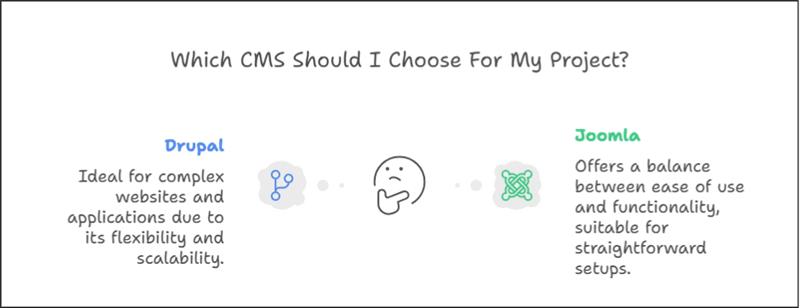
Drupal and Joomla solve very different content challenges, depending on your website’s size, complexity, and goals. This guide walks you through their strengths, weaknesses, and key features, helping you see which CMS will work best for your team today and scale with you in the future.
Here's What You’ll Learn
- The key differences between Drupal and Joomla across usability, security, scalability, and cost.
- Which CMS fits your business goals, technical team, and long-term digital strategy.
- How Drupal and Joomla handle AI, multilingual sites, and headless architecture in 2025.
Choosing the right CMS in 2025 is no longer just about “which one is easier” or “which one is cost friendly.” The conversation has shifted. Websites today are not just pages. They’re ecosystems.
They integrate with CRMs, marketing automation, and ERPs, serve headless front ends, get connected to mobile apps, handle structured data, multilingual content, and provide personalized user flow. In short, the CMS is not just a CMS anymore but a content infrastructure.
Which often leaves business owners with an important decision of what is the right choice between Drupal vs Joomla.
So today, we are not doing the usual shallow “this has features, this has advantages, they’re both great, choose anything” type article. We’re approaching this like a decision architect, landing you at the right choice.
Table of Contents
Key Insights
- If you anticipate scale, complexity, granular content modelling, multi-language structures, headless front-end plans, Drupal is the choice for the future.
- Drupal is built for long-term evolution, especially paired with custom backend development services.
- If you want to launch quickly, manage content without a big learning curve, need fast editorial workflows for simple-medium complexity sites; Joomla fits cleaner.
- Joomla is simpler, more approachable, and gives “quick control” to small-mid publishers, eCommerce, and communities.
What is Drupal?
Drupal is an enterprise-grade content management system built for organizations that expect complexity to increase over time. It has a deeply modular architecture and a structured content first approach.
Meaning, you don’t just throw pages in it, you design your content model like a product’s backend system.
Drupal is widely used for:
- national or state government portals
- enterprise publishing & newsrooms
- corporate knowledge systems / intranets
- editorial environments with 100+ content types
- multiple country/language brand ecosystems
- headless, app-connected digital experiences
Drupal fits when you know the site/application won’t be “static”.
It’s for teams who know that content rules, roles, personalization, workflows, API consumption, mobile front ends, etc. will keep evolving every quarter.
Think of Drupal as, “You are not just building pages, you are building a backend content platform that will power multiple digital touchpoints for years.”
Drupal is not merely a CMS. Drupal is a content framework.
What is Joomla?
Joomla is a mid-level flexibility CMS with more capability than WordPress (for structured content), but significantly easier to adapt than Drupal. It is the “smart compromise” between editor usability and technical power.
It is widely used for:
- mid-sized content-based websites
- education platforms, universities
- NGOs / non-profit communities
- online magazines, regional media websites
- small-medium eCommerce setups
Joomla appeals to orgs who say: “We want power, we want flexibility, but we don’t have enterprise engineering resources, and we need to move fast.”
Drupal vs Joomla? Choose the CMS That Scales with Your Growth
In the Drupal vs Joomla conversation, the real question isn’t which CMS is “better”, it’s which one aligns with the future trajectory of your digital platform.
Are you building a content engine that will be powering multiple regions, products, languages and front ends over the years? Or do you need a flexible, smart CMS that can get you live fast and give editors strong control without a steep learning curve?
The trade-offs start making sense only when you map each CMS to the nature of the organization, the team, and the future complexity curve. To lead you towards the right decision, here is the only comparison guide you need for Drupal vs Joomla.
1) Ease of Use
The first place where Drupal and Joomla visibly separate is usability.
Drupal is designed from a developer’s mental model.
If you want to use Drupal the right way, you need to understand “how data flows inside Drupal.” You must understand fields, content types, taxonomy, permissions, entities, views, etc. Beginners struggle in the first 15–45 days unless someone guides them.
Joomla is designed from an editor’s mental model.
Menus, modules, content, and configs are far more GUI-driven. A non-technical content manager can jump in, learn about the panel in a day or two, and start publishing with confidence.
So, if your core team is content writers or editors, Joomla is easier to adopt.
If your core team consists of devs and architects, Drupal unlocks more power.
2) Customization Depth
This is the biggest gap between both platforms.
Drupal is not “just a CMS” it is a content modelling engine. If you have complex use cases like “a piece of content has 4 variations based on user role or language or device,” Drupal can handle it at the database level. You get:
- entity-level configuration
- custom workflows
- complex relationships
- granular access control rules
- highly structured content models
Drupal often integrates with complex backend systems. Understanding which programming language or framework powers your applications is important. For example, choosing between Java or Python can influence your backend development scales. We’ve covered this in detail here: Java vs Python: Which is the Better Option for Businesses in 2025 and beyond?
Joomla is customizable too, but it works like a traditional CMS. You add plugins, use modules, use components, it’s flexible, but the data modelling is not deep engineered like Drupal.
So, if your project grows into an application-like content system, Drupal is architecturally the right investment.
3) Security
Drupal has enterprise security DNA. It is literally used by:
- U.S. govt departments
- UN portals
- Banks and financial institutions
- Regulated compliance-driven industries
There is a formal security advisory group, critical module patches, tracked vulnerability announcements, and an extremely strong “security culture.”
Joomla is also secure, but the ecosystem’s maturity is different. The security approach is less enterprise-oriented historically and more community-driven.
4) Performance
They both perform well but the journey to reach that performance is different. Drupal can handle extremely high-scale traffic (millions per day). But it requires proper DevOps maturity:
- reverse proxy (Varnish)
- CDN layer
- correct caching setup
Once set up right, Drupal is a beast.
Joomla gets to “good performance” faster with less engineering effort. But at an enterprise scale, Drupal has more proven references and benchmarks.
5) Multilingual Capability
Drupal is considered the best CMS for multilingual structures in the PHP world. Everything is multilingual-ready at a structured entity level, not just page level. You can manage:
- 15 to 50 language sites
- per-language menus
- per-language taxonomy
- per-language content variants
Joomla also supports multilingual natively but mostly fits 2–5 language websites, not heavy global publishing ecosystems.
6) Headless / Decoupled CMS Readiness
From Drupal 8 onwards, Drupal became API-first.
- JSON:API is in core
- REST is in core
- GraphQL is available via module
To fully utilize Drupal’s API-first capabilities and deliver seamless multi-channel experiences, you can also partner with a front-end development company.
Joomla can be used headless, but it’s not the industry’s standard use case. Drupal is far more aligned with the “headless future.”
7) Typical Team Size / Skill Profile
Drupal fits teams where there is an engineering backbone, it’s usually used by mid to large orgs:
- backend devs
- content architects
- DevOps
- QA
- PMs
- editors
Joomla fits smaller agile teams, there might be 3–10 people handling everything like:
- NGOs
- local govt bodies
- mid-sized publishers
- small web agencies
8) Cost Range
Drupal requires higher investment upfront because architecture needs to be done correctly from the base. But long-term costs are lower because there is less technical debt.
Joomla is cheaper to start with and can move fast. But as complexity increases, you end up patching with modules, which increases long-term maintenance overhead.
9) Project Types Where Each CMS Typically Wins
Drupal wins when:
- complexity is high
- security matters
- future scaling matters
- multilingual is heavy
- external systems need to consume content via APIs
Joomla wins when:
- team wants faster adoption
- content managers need independence
- complexity is low-medium
- multilingual is limited
So, the Drupal vs Joomla trade-off framing becomes clear:
Choose a drupal development company if you are looking for long-term evolution, headless capability and enterprise scale.
Pick Joomla development services for practical control, faster launch and easier ops.
Understanding The Core Capabilities of Drupal vs Joomla
Now that the comparison is clear, before you make the final choice, it’s important to understand that both Drupal and Joomla solve content problems, but they solve them at different scales of businesses.
So, let’s now break it down into the core capabilities each platform brings to the table. This will help you clearly see which CMS aligns with your scenario.
Key Features of Drupal
1) Content Modelling Power: Drupal allows you to create “content types” with fields, relations, taxonomies & data structures the way a database architect thinks.
Where WordPress & Joomla thinks in terms of “posts + pages”, Drupal thinks in terms of data architecture.
2) Enterprise Access Control: RBAC (role-based access control) in Drupal is extremely advanced and easy to configure. For example, you can create roles like:
- Editors who can edit only specific fields, but cannot publish the content
- Translators who can edit content only in certain languages, but not touch others
These types of permissions are not complex or customized in Drupal because of their standard capabilities that Drupal handles naturally.
3) Headless & API-First by Design: Modern digital ecosystems connect the following
- Web
- Mobile app
- React/Vue front ends
- Kiosks
- Internal dashboards
Drupal is natively built to serve APIs to all. In fact, many modern buildings treat Drupal as a pure backend content engine. This is where enterprise backend development services companies use Drupal as a content microservice.
Since Drupal often integrates multiple backend systems, choosing the right framework can make a big difference in performance. For insights on selecting the most suitable enterprise framework, check out our detailed comparison: .NET vs. Java: Which Framework is Best for Your Business Needs?
4) Advanced Internationalization: Drupal has one of the industry’s strongest multilingual cores. If you’re building global content, these matters.
5) Enterprise Caching & Performance Layering: Cache tags, intelligent invalidation, reverse proxies, and multi-layer caching all exist natively.
Key Features of Joomla
1) Faster Onboarding: Joomla’s admin UI feels familiar, clean, and visual for most editors.
Without technical training, teams can start adding content, creating menus, and publishing updates within hours of days.
2) Templates + Template Overrides: You can get a “semi-custom” design quickly by combining a base template with template overrides. This is powerful for teams who want unique branding and layouts but don’t want to invest in full custom UI engineering.
3) Extensions Ecosystem: Joomla has a large extension directory think of them as plugins that add capabilities like:
- forms
- SEO utilities
- commerce & transactions
- directory listings
- membership areas
These extensions are easier to adopt versus Drupal modules, but not as deeply integrated into the core content model.
4) Multilingual Out of the Box: Like Drupal, Joomla also has native multilingual support, no plugin is required. For medium-sized publishers operating in 2–5 languages, this is extremely convenient and fast to set up.
5) The Perfect Middle Ground for Non-Enterprise Builds: This is the real sweet spot for Joomla development services.
- If you want more control than WordPress, you get it.
- If you want less complexity than Drupal, you get that too.
Joomla is the platform for organizations that want to scale content sustainably but do not need a fully engineered enterprise content data model.
Pros, Cons & Who Each CMS is Actually Built For?
| CMS | Pros | Cons | Best For |
|---|---|---|---|
| Drupal |
|
|
Enterprise orgs, global brands, government, high-scale content networks, API-driven digital products |
| Joomla |
|
|
Mid-scale publishers, media portals, NGOs, education sites, small businesses with moderate complexity |
Where Does AI Fit in Drupal vs Joomla?
AI is not just about generating copies. By 2025, AI will become content with orchestration, personalization, and governance. This is where Drupal and Joomla start to clearly separate. Drupal is far more AI-ready because it treats content as structured data, not pages.
What does that mean practically?
- AI models can easily query Drupal content via APIs.
- AI-based personalization engines can plug into Drupal entities.
- AI chatbots can fetch data from Drupal like they’re pulling from a database.
- AI-assisted content governance (taxonomy + workflows) is easier.
This is why most enterprise AI content stacks (CDPs, ML personalization, headless front ends, LLM-based search) lean towards Drupal.
Joomla can do AI but usually through plugins/extensions and mostly on the editorial side:
- AI assisted content writing
- AI SEO suggestions
- AI-based tagging (via plugins)
But AI cannot deeply manipulate content architecture in Joomla unless heavily customized, because Joomla is not designed as a structured content framework the way Drupal is.
Migration Playbook: Moving Between Joomla and Drupal
Migrating a CMS is not just about “export and import.” Content models, modules, multilingual setups, SEO, and user experience all need careful planning. Many organizations hire CMS developers at this stage because proper migration ensures minimal downtime, data integrity, and SEO preservation.
Moving from Joomla to Drupal
1. Map Content Types & Structure
Identify all Joomla content types (articles, categories, custom post types) and determine their equivalent in Drupal (content types, entities, fields, taxonomies). This step ensures that Drupal’s structured content architecture accurately represents existing data.
2. Map Extensions to Drupal Modules
Joomla plugins/extensions may have Drupal equivalents or require custom development. Plan which modules will replace existing functionality.
3. Prepare Redirects & SEO Preservation
Document all URLs from Joomla. Set up 301 redirects in Drupal to avoid losing search engine rankings.
4. Rebuild Menus & Taxonomy
Recreate navigational menus and taxonomy terms in Drupal. Ensure hierarchy and relationships to mirror the original site.
5. Content Import
Only after structure, modules, and menus are ready, import content. Use migration tools or custom scripts for accuracy.
6. QA & Multilingual Validation
Test multilingual content, media, and workflows. Validate user permissions, editorial workflows, and front-end rendering. Migrating to Drupal is a complex process, hence, to hire Drupal developers is the best path rather than making things heavy on your own.
Moving from Drupal to Joomla
1. Simplify the Content Model
Identify which Drupal content types are essential. Joomla cannot handle deeply nested or highly relational content like Drupal, so simplification is critical.
2. Flatten Structured Content
Convert complex entities, fields, and relationships into a simpler format that Joomla can manage. Merge content where necessary without losing meaning.
3. Content Migration
Use migration scripts or tools to move content. Ensure media, categories, and metadata are preserved.
4. Rebuild SEO Metadata & URLs Carefully
Joomla may require manual setup for SEO fields, metadata, and redirects. Carefully recreate page titles, meta descriptions, and URLs to maintain search performance. Partnering with experienced CMS development company or migration specialists is highly recommended for smooth execution, when choosing to migrate from one to another.
Final Recommendation
Making the choice of Drupal vs Joomla is no longer just about building a website. It is about defining the foundation of your content business, the system that will grow with your organization, adapting to your audience, and supporting your long-term digital strategy.
If you want to control, scale, and technical depth go for Drupal. If you want speed, comfort, and mid-complexity efficiency, choose Joomla.
Both platforms are capable, but they serve very different paths. The real question is not what you need today, but where your business aims to be 18 months from now, and which CMS will empower that vision most effectively.
Frequently Asked Questions
1. Is it possible to use headless CMS using Drupal or Joomla?
Yes. Drupal is API-first, and is compatible with JSON:API, REST and GraphQL, which is why it is the best choice when driving a mobile app, a React/Vue front end, and a multi-channel experience. Joomla is also capable of being headless although it is not as standardized to be used in such cases.
2. I do not have much technical knowledge which CMS should I use?
Joomla is more of an editor-first system, which is why the non-technical teams can easily manage content, menus and modules in a short period of time. Drupal is a developer-first mentality and should be managed by professionals who are trained in engineering, or by contracting a Drupal developer.
3. Which CMS is better to use for high-traffic websites?
Drupal has the ability to support very large-scale traffic with a caching system, reverse proxies, and CDNs. Joomla performs well with a reduced amount of configuration and has not been tested at an enterprise level.
4. Is it possible to combine AI tools with Drupal or Joomla?
Drupal has a structured content model that is open to AI personalization, chatbots, ML-driven search, and content governance. The main ways Joomla can use AI are content creation, tagging, or SEO suggestions within the plugins.






